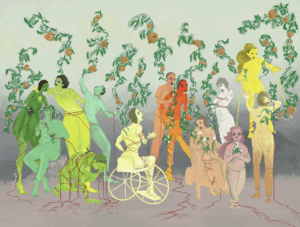Plenty of artists have spoken out about AI “art” and the use of artists’ works—written and visual—to train AI models without the creators’ permission. It’s a tired topic at this point, and it is quite often met with the same counterargument: “What about disabled people? AI makes art accessible.“
But is this really accessibility, or is it just disabled people being used as a shield from criticism? The truth is, there are countless disabled artists who create art without any need for AI.
Frida Kahlo was physically disabled (an amputee and a wheelchair user) and depicted her experiences with chronic pain in her art, often painting self-portraits while bedbound and recovering from surgeries. Beethoven is famous for compositions he made after losing his hearing, relying on knowing the rules of music instead of hearing the notes. Chuck Close was a visual artist who was born with neurological disabilities that impacted his art style and his approach to painting. Following a stroke, Close was left paralyzed from the neck down with limited function in his limbs, but he employed adaptive methods to continue painting regardless. Sally Gardner is an author and illustrator who has published many books and won awards for her writing despite struggling with learning to read in her early life due to dyslexia.
These people, and the countless other disabled artists who have and do create art now, show that disability has not prevented the creation of beautiful art.
This begs the question: if disabled people have been able to create art for so long, why are they now being used to defend the use of AI art? This question is especially important when considering that disabled artists have actually spoken out against this idea.
In response to a tweet claiming that generative AI “brings down barriers” that disabled people face in accessing the art community, many disabled artists spoke out against the idea that generative AI is the only way for them to create art. Notably, Daniella Ryan, an entertainment critic and essayist, said, “I’m a disabled writer and artist and generative AI is basically the worst thing to ever happen to art. If you TRULY want to make art, you find a way. If you want to democratize art there are a million other ways besides straight-up theft.”
The people that argue in support of generative AI as an “accessibility tool” rarely seem to care about the opinions of disabled artists, though. This is where the theft comes in again—not only is AI stealing from artists, but the people who support it are “stealing” and exploiting the disabled identity and experience to defend the unethical practices.
This argument often frames disabled people as incapable of creating art without the help of AI because they are limited by their disabilities. This directly feeds into the ableist stereotypes that patronize and infantilize disabled people by seeing their disabilities first and their capabilities never. In fact, this argument directly contradicts a very important concept in disability inclusion: presuming competence.
Presuming competence is exactly what it sounds like: assuming that people with disabilities are capable of doing everything another human being can. This mindset is one that directly opposes the ableist idea that because someone looks, communicates, or thinks differently than most people, they lack intelligence, understanding, or the capacity to do things. This is a highly important topic in disability advocacy because it is one of the most integral ways of ensuring that people with disabilities are treated with dignity and respect.
Considering that the way disabled people are framed in the argument to support AI “art” goes directly against the idea of presuming competence, it is safe to say that it also feeds into the ableist beliefs that presuming competence was designed to combat.
Supporting this false, pervasive belief that disabled people are less competent than non-disabled people is harmful and reductive. It goes directly against the years of work and advocacy done by the disability justice movement and may, in turn, support the undoing of that progress.
Using ableist arguments to defend AI “art” doesn’t just condone stealing from real artists, it also perpetuates harm against a community that has already had to fight so hard to have their voices heard.





